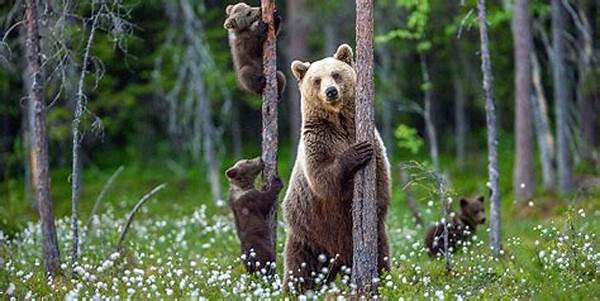In recent years, the push for bear habitat restoration efforts has become more than just a buzzword. This crucial environmental initiative is a call to action for conservationists, communities, and governments worldwide, aiming to restore natural habitats for these magnificent creatures. Bears, vital to the ecosystem, face increasing challenges due to habitat destruction, climate change, and human encroachment. These threats have sparked a movement focused on the restoration of their natural environments to ensure their survival and continuity.
Why Bear Habitat Restoration Rocks
Bear habitat restoration efforts aren’t just a walk in the park; it’s a game changer for our beloved bears. Picture the scene: sprawling landscapes, roaring rivers, and lush forests becoming a haven for these amazing creatures again. By reviving these habitats, we’re not only giving bears a fighting chance but also working toward a healthier planet. These efforts help reestablish ecological balance, bring back native plant species, and ultimately benefit other wildlife too. The ecosystem gets a major boost, and humans get to observe and appreciate bears in their natural glory—win-win, right? So, rolling up our sleeves and diving into this restoration gig is, hands down, the coolest gig around.
Key Components of Bear Habitat Restoration
1. Reviving Forests: A crucial part of bear habitat restoration efforts is planting trees and nurturing forests for the bears to thrive.
2. Connecting Corridors: Creating wildlife corridors is like building a highway for bears, linking fragmented habitats.
3. Restoring Rivers: Cleaning and revitalizing rivers gives bears access to essential water sources and fishing opportunities.
4. Limiting Human Impact: Educating the public about minimizing development helps protect bear habitats from future threats.
5. Monitoring and Research: Continual research ensures the success of bear habitat restoration efforts by tracking progress and adapting strategies.
Challenges and Triumphs in Bear Habitat Restoration
Bear habitat restoration efforts often hit chunky roadblocks, but overcoming them is all part of the journey. The relentless push to reclaim these spaces comes with its mix of challenges and victories. One major hurdle is human development, which keeps slicing through natural environments, turning bear havens into concrete jungles. But hey, overcoming these challenges is half the battle. By addressing human impact and advocating for sustainable alternatives, conservationists are making waves. The triumph? Seeing a thriving bear population! Successfully restored habitats boast rich biodiversity and happier bears roaming free—thanks to a collaborative effort from folks who truly care.
The Impact of Bear Habitat Restoration on the Ecosystem
Bear habitat restoration efforts have a ripple effect on the ecosystem, impacting all its components. Restoring these habitats contributes significantly to biodiversity, boosting the numbers of various plant and animal species. Thriving plant life sets the stage for a balanced ecosystem, supporting everything from tiny insects to majestic predators like bears. Additionally, restored waterways ensure clean and abundant resources for all creatures, enhancing the overall health of the environment. Beyond the flora and fauna, these efforts positively affect humans as well, offering opportunities for recreation, education, and a heightened appreciation for nature. By understanding the broader impact, it’s clear why bear habitat restoration is a top-notch priority.
The Significance of Bear Habitat Restoration
Bear habitat restoration efforts are like that legendary tune that never goes out of style. Why? Because they’re crucial for maintaining ecological harmony, man. Bears aren’t just cute and fluffy; they play a major role in spreading seeds and maintaining healthy forest ecosystems. Without these efforts, we’d be looking at a messed-up balance, not to mention a serious hit to biodiversity. Taking strong action to restore bear habitats means recognizing their importance in the bigger picture. So, whether you’re a tree hugger or just someone who digs bears, these restoration movements hit home for everyone.
Community Involvement in Bear Habitat Restoration
Dude, community involvement in bear habitat restoration efforts is like the secret sauce for success. Imagine local folks coming together, joining forces with conservationists to make a real difference. Whether it’s volunteering to plant trees, participating in educational workshops, or rallying for local policy reforms, this kind of grass-roots participation is where the magic happens. It fosters a sense of ownership and pride, bridging the gap between humans and the natural world. By getting involved, communities not only help revive bear habitats but also become advocates for broader environmental changes. When everyone pitches in, that’s what turns the tide for effective habitat restoration.
Wrap-Up: The Big Picture of Bear Habitat Restoration
At the end of the day, bear habitat restoration efforts boil down to one thing: harmony. Nature and humanity, living in sync. These initiatives are more than just restoration projects; they symbolize hope for a sustainable future. By actively taking part in these efforts, we show our commitment to preserving the wonders of nature for generations to come. It’s about valuing our world as a shared space, where bears have their rightful place. So, here’s to pushing the envelope, thinking big, and making sure our furry friends never face eviction notices from their own homes!

